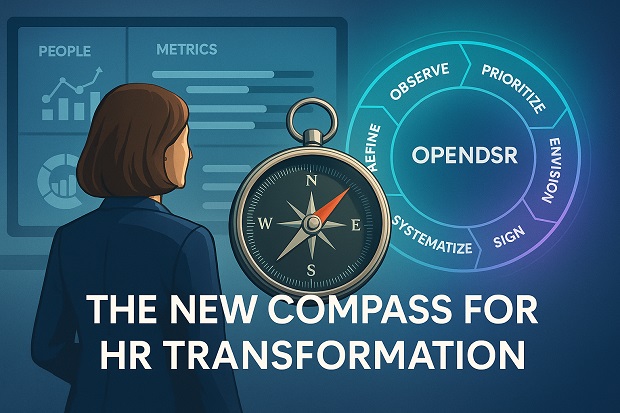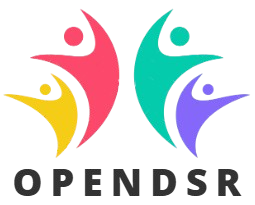
HR’s New Compass: Why OPENDSR Matters Now
HR at a Crossroads
The world of work has changed forever.
Hybrid work blurred boundaries. AI rewrote job roles. Employee expectations evolved from “career” to connection.
And HR—the traditional custodian of people and culture—is now standing at a critical crossroads.
On one side lies the legacy path: policies, processes, and performance metrics.
On the other, a new frontier: experience, empathy, and intelligence.
The question is no longer “How do we manage employees?”
It’s “How do we design human experiences that make work worth doing?”
Enter OPENDSR—the new compass for HR transformation.
Why HR Needs a Compass, Not a Calendar
For decades, HR has worked in cycles—annual surveys, yearly reviews, quarterly engagement reports.
But human emotion doesn’t follow calendar quarters.
Employees experience micro-moments every day—recognition, frustration, trust, confusion—and each moment shapes culture.
Traditional HR systems simply can’t keep up.
Without real-time insight, HR ends up reactive:
- Running surveys after people quit.
- Launching engagement programs without context.
- Measuring output, not experience.
The result? A gap between what HR knows and what employees feel. OPENDSR closes that gap.
What Is OPENDSR?
OPENDSR stands for Operating Principles for Empathy-led Navigation, Design Standards, and Real-Time Intelligence.
It’s not software—it’s a structured way to think, act, and evolve people experience.
It helps HR leaders move from administration to experience architecture.
At its core, OPENDSR integrates three lenses:
Lens
Description
Empathy-Led Navigation
Understanding what employees truly experience day-to-day and guiding teams through it.
Design Standards
Creating consistent, inclusive, and repeatable human experiences.
Real-Time Intelligence
Using live data to observe, act, and refine faster than traditional cycles.
Together, these principles form the HR compass—pointing toward decisions that are both human-centered and insight-driven.
The Old vs New HR Paradigm
Traditional HR
OPENDSR-Led HR
Periodic surveys
Continuous listening
Policies & control
Design & co-creation
HR as service center
HR as experience architect
Data after the fact
Real-time intelligence
Annual goals
Dynamic trust loops
This shift is not theoretical—it’s operational.
OPENDSR gives HR the framework to act in rhythm with people, not in reaction to problems.
Step 1: Observe – The Art of Real Listening
The first act of transformation is observation.
OPENDSR helps HR leaders build a listening architecture beyond forms and surveys.
Signals come from:
- Chat tone in collaboration tools.
- Feedback snippets after 1:1s.
- Exit and stay interviews converted into emotional maps.
- “Moments That Matter” dashboards visualizing peaks and friction.
These help HR teams see the lived culture, not just its documentation.
“You can’t improve what you can’t feel.”
Step 2: Prioritize – Focusing on What Moves the Needle
With hundreds of insights, HR needs focus.
OPENDSR introduces Friction Priority Matrices, ranking employee issues by impact, frequency, and emotional cost.
Instead of 50 disconnected actions, HR focuses on the top 5 that truly shift experience—such as manager empathy, internal communication, or growth transparency.
This prevents “initiative fatigue” and channels effort where it matters most.
Step 3: Envision – HR as Experience Designer
In the Envision phase, HR becomes co-creator with employees.
Design Thinking sessions replace policy reviews.
Storyboards replace PowerPoints.
Employees sketch what better days look like.
Examples:
- Re-imagining performance reviews as “growth dialogues.”
- Co-creating parental leave reintegration journeys.
- Designing micro-rituals that reinforce belonging.
When employees co-design experiences, adoption becomes natural—and culture feels co-owned.
“The future of HR is not paperwork—it’s prototyping.”
Step 4: Navigate – Turning Strategy into System
Ideas only work when mapped.
OPENDSR’s Navigate phase helps HR translate insights into action roadmaps—defining:
- Who owns each experience zone (onboarding, recognition, career growth).
- When to act (quarterly pulses, monthly check-ins).
- Which systems support it (Teams, Viva, HRIS).
Navigation turns vision into cadence—clear, trackable, repeatable.
Step 5: Design – Standards That Humanize Scale
Scaling empathy is hard without design standards.
OPENDSR provides Experience Templates and Interaction Guidelines so empathy becomes operational:
- Feedback format that feels personal yet measurable.
- Recognition rituals embedded in Teams or Slack.
- Communication tone guides ensuring inclusion.
- EX dashboards merging HR, IT, and wellbeing data.
Design converts good intentions into reliable employee experiences, no matter who delivers them.
Step 6: Systematize – Data Meets Empathy
Systematization doesn’t mean mechanization—it means consistency.
OPENDSR helps HR weave empathy into existing tech stacks:
- Microsoft Teams / Viva: automated nudges, feedback bots.
- SharePoint (CorporateOne): dashboards, reflections, EX journals.
- Power BI: live sentiment analytics.
- HRMS / ATS: connected lifecycle data.
This converts “soft” experiences into measurable, traceable systems—without losing the human tone.
“Technology amplifies empathy when it’s designed with it.”
Step 7: Refine – The Rhythm of Continuous Learning
Transformation isn’t a project; it’s a pulse.
In OPENDSR’s Refine phase, HR reviews every quarter:
- What improved engagement?
- What felt performative?
- Where did culture strain?
- How can next cycle evolve?
Refinement turns experience management into a living ecosystem—adaptive, self-aware, and data-driven.
Case Study: A Telecom Giant Finds Its HR Compass
Challenge:
A 12,000-employee telecom firm had high engagement scores but low trust. HR felt overwhelmed—too many initiatives, not enough insight.
OPENDSR Application:
- Observe: Employee sentiment analysis revealed “invisible feedback loops.”
- Prioritize: Focused on managerial empathy and communication friction.
- Envision: Co-created “Human Signals Dashboard.”
- Navigate: Mapped ownership—every manager accountable for pulse follow-up.
- Design: Introduced new 10-minute weekly reflection ritual.
- Systematize: Embedded in Teams + SharePoint workflow.
- Refine: Iterated quarterly; trust score rose steadily.
Results (9 months):
- Trust index ↑ 22 points
- Response to feedback ↑ 47%
- Voluntary attrition ↓ 14%
- HR perceived as “Experience Partner,” not policy gatekeeper
What HR Leaders Are Saying
“OPENDSR gave us language for what we always felt—empathy as infrastructure.”
— Chief People Officer, Retail Group
“Our HR dashboards finally tell human stories, not just metrics.”
— EX Director, Tech Enterprise
“It’s like having a GPS for culture.”
— VP Talent, Banking Sector
The Strategic ROI of OPENDSR for HR
Impact Area
Average Improvement
Result
Engagement Responsiveness
↑ 40–50%
Faster action from real-time listening
Manager Empathy Score
↑ 30%
Better feedback & coaching culture
Retention
↓ 15–25% attrition
Trust + purpose alignment
HR Efficiency
↑ 25%
Unified data + automated workflows
Culture Trust Index
↑ 20+ pts
Transparent loop closing
EX ROI
Measured via sentiment vs performance correlation
Data-driven value of EX
From HR Metrics to Human Signals
OPENDSR reframes HR analytics entirely.
Instead of dashboards filled with static KPIs, HR tracks human signals:
- Connection pulse
- Friction intensity
- Recognition flow
- Manager warmth index
This turns data into dialogue—a continuous loop between feeling and fact.
Integrating OPENDSR into HR’s Digital Ecosystem
CorporateOne, the SharePoint-based EX platform built on OPENDSR, becomes HR’s natural command center:
- Host employee journey maps, dashboards, and reflection journals.
- Run AI-enabled One Assistant for feedback summarization.
- Deliver recognition and learning flows directly through Teams.
- Feed Power BI with real-time sentiment intelligence.
By embedding OPENDSR principles into these everyday tools, HR gains both visibility and velocity.
The Future: HR as Architect of Experience
The HR function of tomorrow won’t be known for policies—it will be known for experience design.
HR leaders will be the architects of meaning, blending empathy, analytics, and agile design into one continuous system.
OPENDSR isn’t just a framework; it’s the mindset for that future.
It empowers HR to:
- Lead transformation with clarity.
- Align culture with business velocity.
- Turn every human moment into measurable intelligence.
“HR’s role is no longer to enforce. It’s to illuminate.”








